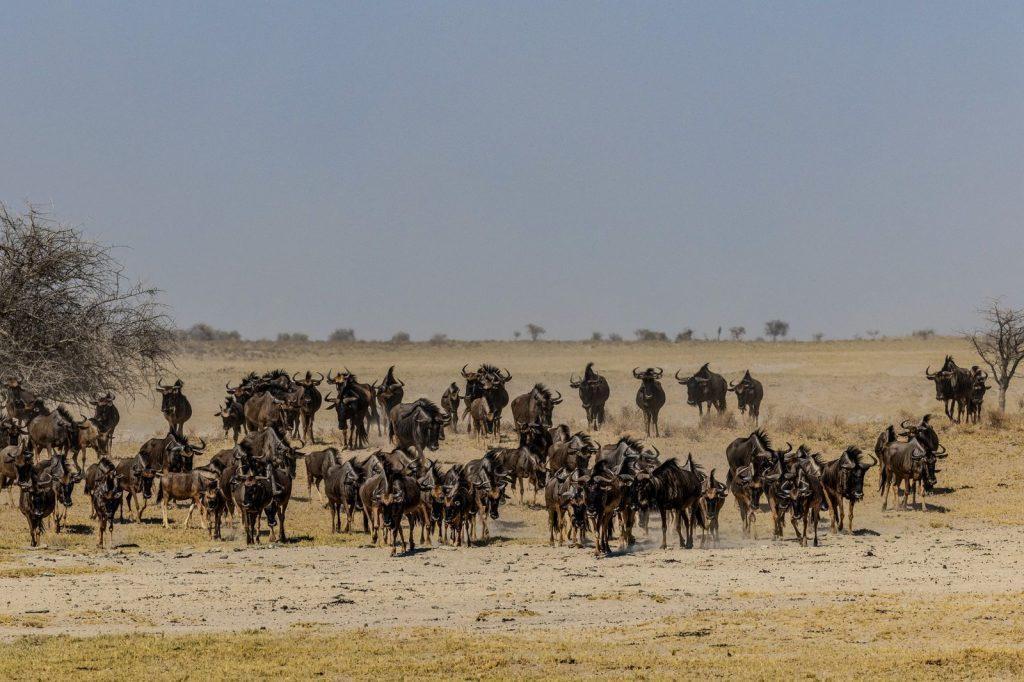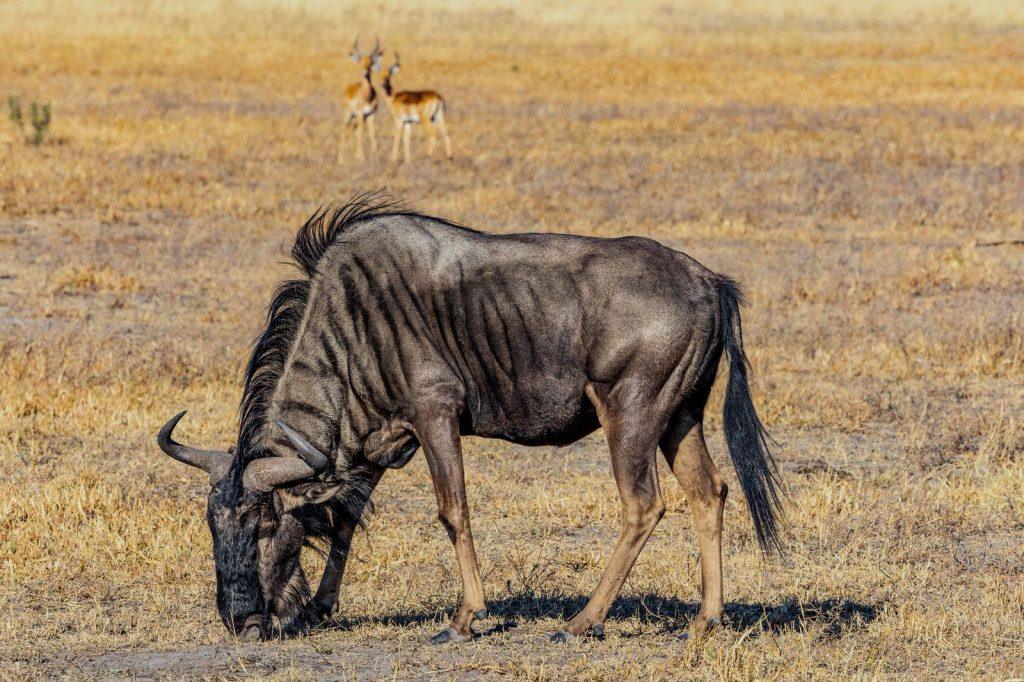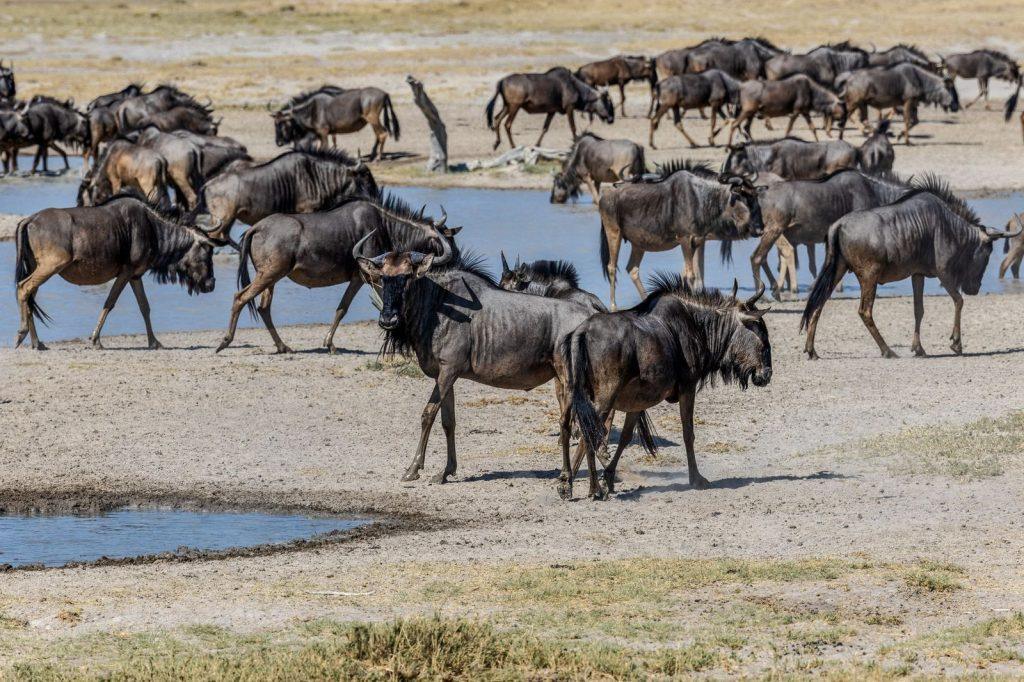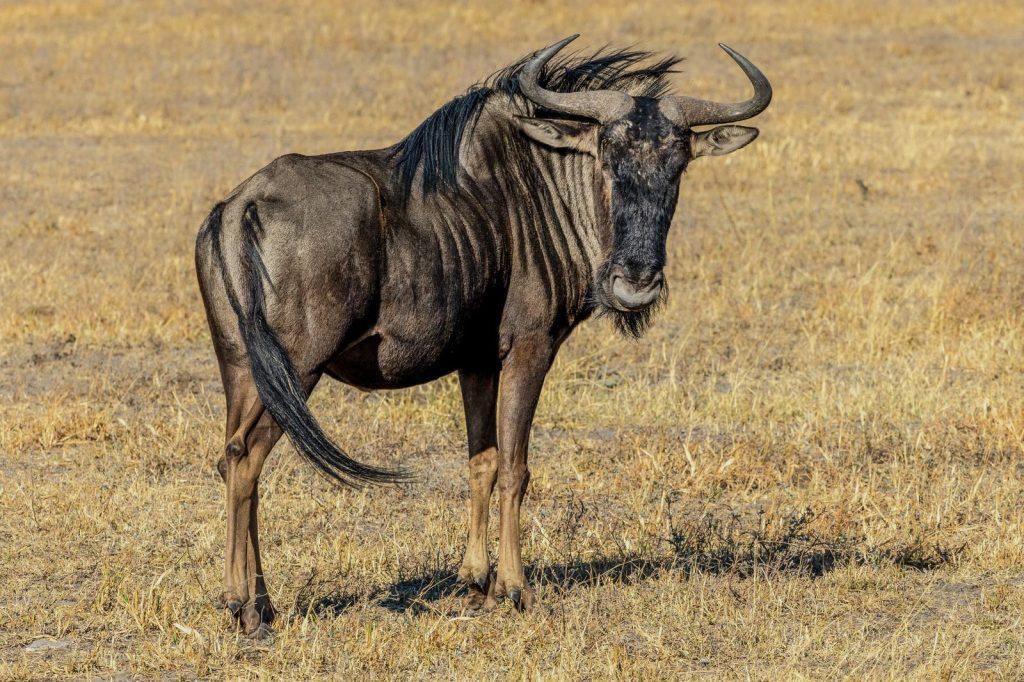Across the endless plains of East and Southern Africa, a silent actor shapes the landscapes and sets the rhythm of wildlife: the blue wildebeest. More than just a grazer, it embodies the pulse of ecosystems, linking species, soils, and climate in a fragile yet essential balance.
Article by Damien Lafon & Photographs by Cécile Ducreux

The blue wildebeest, a powerful silhouette of the plains
Recognizable by its curved horns and coat marked with dark stripes, the blue wildebeest (Connochaetes taurinus) stands as one of the emblematic mammals of the savanna. Its stocky frame and rugged appearance contrast with its surprising speed, as it can reach 80 km/h to escape predators. Living in vast herds, sometimes numbering several thousand, it shapes the land alongside the plains zebra, Thomson’s gazelle, and the ostrich. Its massive presence embodies the delicate balance between animal abundance and ecological constraints. Without it, the landscapes of the Serengeti and Masai Mara would lose their dynamic rhythm.
The great migration, a theater of life and death
Every year, more than a million blue wildebeests embark on the most remarkable terrestrial migration known. Their journey covers nearly 3,000 kilometers, in constant search of fresh grass and water. Guided by seasonal rains, they cross arid plains, tumultuous rivers, and rugged landscapes, drawing with them a varied fauna. Zebras, gazelles, and elands accompany this colossal movement, forming a living army in perpetual motion. Yet this vital flow also attracts Africa’s great carnivores: lions, hyenas, and leopards rely on the migration as a crucial food source. Each river crossing becomes a brutal stage where life and death collide.
An ecological role as engineers of the savannas
The blue wildebeest is not limited to its role as a tireless migrant. It also acts as a true ecological architect. By grazing short grasses, it prevents the savanna from turning into impenetrable thickets, benefiting oryx, impala, and buffalo. Its movements aid in the dispersal of seeds, ensuring plant diversity. Its droppings fertilize the soil, stimulating grassland regeneration and nourishing insects and microorganisms. Through this constant activity, an entire web of species benefits, from seed-eating birds to top carnivores. This invisible role illustrates how an apparently ordinary herbivore can become the pivot of an entire ecosystem.
Did you know?
Blue wildebeests appear to predict rainfall thanks to a still-mysterious physiological sensitivity. This ability intrigues climatologists, as it could serve as a natural indicator of climate shifts in sub-Saharan Africa.

Predators and human threats
Although the silhouette of the blue wildebeest seems robust, it does not protect against all dangers. Its main natural predators remain lions, hyenas, and crocodiles, lurking at strategic crossing points. However, the greatest threats now come from human activity. Poaching, habitat fragmentation, and farm fences block migratory routes. Yet these movements are essential for the species’ survival. In transboundary reserves such as the Serengeti-Mara, wildebeests still find refuge and freedom. Their future, however, depends on concerted action involving governments, scientists, and local communities, to safeguard vital ecological corridors on a large scale.
The blue wildebeest, a barometer of African climate
Beyond its collective strength, the blue wildebeest fascinates through its intimate relationship with climate rhythms. Its movements do not merely follow rains; they seem to anticipate them. Recent studies reveal that herds sometimes begin their migration before rainfall actually arrives. This capacity to detect subtle environmental signals makes it a living barometer, offering climatologists valuable insights into weather changes. The wildebeest thus becomes a scientific witness, reflecting the fragile balance between fauna and climate. Observing its movements is like interpreting a biological clock set to the pulse of the planet.
A universal heritage to protect
Protecting the blue wildebeest means far more than saving a single species. It ensures the continuity of the largest land migration, sustains carnivore food webs, and preserves the living landscapes of the savanna. It also defends a collective memory embedded in African soil for millennia. Conservation initiatives promote the creation of transboundary reserves and secure corridors. Local communities, involved in these projects, become guardians of this heritage. Each wildebeest crossing a river symbolizes the persistence of a fragile balance. Through it, humanity preserves a fragment of the planet’s wild breath.
Did you know?
During river crossings, up to 6,000 wildebeests can cross in a single hour. These spectacular passages sometimes result in deadly stampedes, yet they guarantee the herd’s survival and feed Nile crocodiles, patient predators of the banks.

Follow us on Instagram and Facebook to keep up to date and support our media at www.helloasso.com
This article may be of interest to you: The African Leopard: A Stealthy Predator at the Heart of the Savannahs
